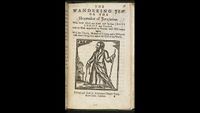Difference between revisions of "Category:Wandering Jew--cinema (subject)"
| Line 1: | Line 1: | ||
[[File:Wandering Jew.jpg|thumb|200px]] | [[File:Wandering Jew.jpg|thumb|200px|[[Wandering Jew|Wandering Jew (Home Page)]]]] | ||
[[File:Cinema.jpg|thumb|200px]] | [[File:Cinema.jpg|thumb|200px|[[Cinema|Cinema (Hime Page)]]]] | ||
'''Works of [[cinema]] related to the [[Wandering Jew]]''' | '''Works of [[cinema]] related to the [[Wandering Jew]]''' | ||
Revision as of 16:58, 7 May 2017
Works of cinema related to the Wandering Jew
Overview
Among the several movies inspired by the character of the Wandering Jew, some were based on Eugene Sue's novel, some on Thurston's play.
To the first group belong the French versions (1904, 1909, 1926), as well as the two Italian versions of 1912 and 1916. All three British versions (1923, 1933, 1947) are instead adaptations of Thurston's play.
The final 1948 Italian version is a very freely based on Sue's novel, but offers an original contemporary setting and twist to the familiar story, by making the Wandering Jew a hero of the anti-Fascist resistance.
All the movies on the Wandering Jew focus on, or include as a prologue, the biblical story which sees the protagonist cursed by Jesus for his lack of compassion. With the exception of the first two shorts of 1905 and 1909, they also include a conclusion in which the persecuted Wandering Jew finally finds forgiveness and redemption.
Three additional movies refer explicitly to the motif of the Wandering Jew, not as an individual character but as a collective symbol of Israel. Two of them (1921, 1933) used the popularity of the subject to promote a pro-Jewish agenda, aimed to end the "suffering" of the Jewish people. The notorious 1940 Nazi film instead exploited the most derogatory elements of the myth, to justify and legitimize the "final solution".
Performing the Wandering Jew (cinema & television)
External links
- [ Wandering Jew] in Internet Movie Database
Pages in category "Wandering Jew--cinema (subject)"
The following 8 pages are in this category, out of 8 total.
1
- Le juif errant (The Wandering Jew / 1904 Méliès), short film
- La légende du Juif errant (The Legend of the Wandering Jew / 1909 Jasset), short film
- L'ebreo errante (The Wandering Jew / 1912 Roma Film), feature film
- L'ebreo errante (The Wandering Jew / 1916 Paradisi), feature film
- Theodor Herzl, der Bannerträger des jüdischen Volkes (The Wandering Jew: The Life of Theodore Herzl / 1921 Kreisler), feature film
- The Wandering Jew (1923 Elvey), feature film
- Der vanderer Yid (The Wandering Jew / 1933 Roland), feature film
- The Wandering Jew (1947 Barry / @1920 Thurston), British (TV) production (play)
Media in category "Wandering Jew--cinema (subject)"
The following 4 files are in this category, out of 4 total.
- 1926 Luitz-Morat (film).jpg 148 × 216; 13 KB
- 1933 Elvey (film).jpg 343 × 541; 119 KB
- 1940 * Hippler (doc).jpg 325 × 451; 49 KB
- 1948 Alessandrini (film).jpg 230 × 345; 46 KB





